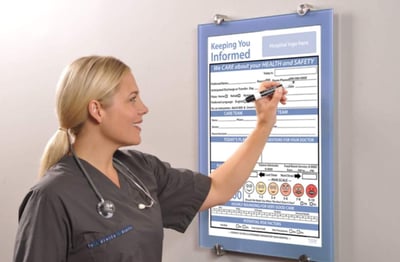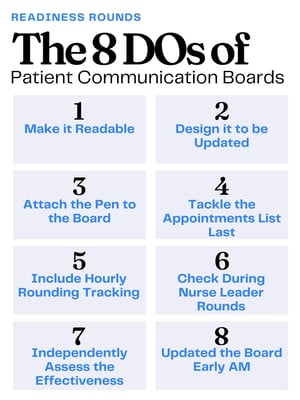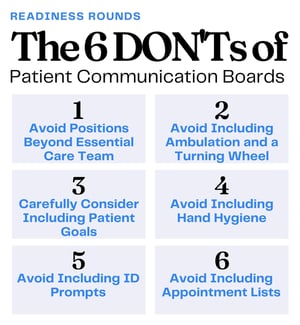Patient Satisfaction - 5 Key Strategies for Your Hospital Environment
Read CEO Don Death's article on Patient Satisfaction's The Halo Effect & 5 Key Strategies for Your Hospital Environment
Patient communication boards play a pivotal role in enhancing both patient satisfaction and a hospital's HCAHPS score and star rating.
Patient communication boards play a pivotal role in enhancing both patient satisfaction and a hospital's HCAHPS (Hospital Consumer Assessment of Healthcare Providers and Systems) score and star rating. These boards serve as instrumental tools in fostering effective and patient-centered communication within healthcare settings.
Here is a comprehensive list of DOs and DON'Ts that will be invaluable when devising an effective patient communication board process for your hospital.
Outline of today’s blog post:
Patient communication boards have become a well-established standard practice in hospitals and considered an integral part of patient centered care. However, despite their widespread use, many questions still surround their effectiveness and impact. This blog aims to address these uncertainties and provide insights into optimizing the use of patient communication boards.
→ Do you ever question the effectiveness of your hospital's communication boards?
→ Are you unsure whether they genuinely contribute to patient safety and enhance the overall patient experience?
With the constant pressures faced by healthcare professionals, it's natural to wonder if these boards are just another form of "busy" work.
Ensuring consistent utilization of communication boards poses its own challenges. How can you be certain that this valuable tool is being utilized consistently across your hospital?
In this blog post, we will explore these questions and provide a structured approach to achieving effective utilization of patient communication boards, improving HCAHPS star results and assisting in building a patient centered care model.
Join us on this journey as we delve into the world of patient communication boards and unlock their potential for improving communication, patient safety, and the overall healthcare experience

Patient communication boards is a multifaceted approach that serves many purposes such as patient safety, patient satisfaction, and as a byproduct, the hospital’s reputation and ratings.
Patient communication boards improve patient safety in hospitals in several ways:
These boards enhance communication between patients, nurses, doctors and other hospital staff by providing a consistent visual and accessible means of conveying important information. Patients can use the boards to express their needs, concerns, enabling healthcare professionals to address them promptly.
Patient communication boards help overcome language barriers, ensuring that patients with limited English proficiency can still effectively communicate their needs.
These boards serve as a constant reminder of important safety protocols and procedures, such as fall prevention, thereby promoting adherence to best practices and reducing the risk of preventable accidents.
Patient communication boards facilitate engagement and participation in the care process, empowering patients to actively participate in their own care and safety by providing feedback, reporting concerns, or asking questions.
These boards improve the continuity of care by allowing different healthcare providers to communicate and share relevant information about the patient, ensuring a comprehensive and coordinated approach to care.
Patient satisfaction plays a crucial role in ensuring a positive healthcare experience. Patient communication boards serve as a powerful tool to contribute to improved patient satisfaction.
These boards provide patients with a platform to actively engage in their care, enabling them to express their needs, preferences, and concerns, thus fostering a positive and personalized experience.
By facilitating clear interactions between patients and healthcare staff, these boards reduce misunderstandings and ensure patients have a complete understanding of their care plan, leading to more informed decision-making and enhanced satisfaction.
Patient communication boards display vital information such as the names and roles of care team members, upcoming procedures, and important reminders, helping patients stay informed, organized, and reassured throughout their hospital stay.
These boards offer transparency and valuable information to loved ones, enabling them to access essential details about the patient's care plan, progress, or specific instructions, fostering trust and comfort in the quality of care provided.
Patient communication boards play a pivotal role in enhancing both patient satisfaction and a hospital's HCAHPS (Hospital Consumer Assessment of Healthcare Providers and Systems) score and star rating. These boards serve as instrumental tools in fostering effective and patient-centered communication in hospitals.
HCAHPS includes a communication domain, which evaluates how well healthcare providers communicate with patients. Patient communication boards directly contribute to this domain by demonstrating the hospital's commitment to effective communication practices.
The "responsiveness" domain of HCAHPS assesses how promptly hospital staff respond to patient needs. By utilizing communication boards, healthcare providers can address patient concerns more efficiently, leading to improved HCAHPS scores.
Patient communication boards contribute to the overall hospital environment, which is a crucial factor affecting HCAHPS scores. A well-organized and patient-oriented environment, facilitated by the presence of communication boards, positively influences patients' perceptions of the hospital's care quality.
Effective communication boards can also enhance the coordination of care during transitions, such as shift changes or transfer to different units. Improved care transitions are associated with higher HCAHPS scores and contribute to a hospital's overall star rating.
As you can see, patient communication boards play a significant role in promoting patient satisfaction by empowering patients, enhancing communication, and fostering transparency.
Moreover, their implementation positively impacts a hospital's HCAHPS score and star rating by contributing to key domains such as communication, responsiveness, hospital environment, and care transitions.
As hospitals continue to prioritize patient-centered care, communication boards remain an indispensable tool in achieving these objectives while bolstering overall patient experience and organizational performance.

Patient communication boards can become excessively cluttered, making them unusable. It is crucial to choose which specific pieces of content will be displayed on the board.
Ask:
→ “Does it hold significance for the patient, their family, and friends?”
→ “Does it provide value to the hospital care team, nurses, physicians, therapists, and other support staff?"
The board must be positioned directly within the patient's line of sight.
Change is an inherent law of the universe. Don’t assume after countless meetings, you will agree on a perfect communication board template. Instead, it is essential to create a board design that allows for easy updates and modifications. By employing an insert-based approach, information can be swiftly and cheaply revised whenever needed.
This framework also facilitates tailoring boards to meet the unique requirements of specialty units.
It is imperative to secure a dry erase marker permanently to the board. Regrettably, as a patient myself, I have witnessed well-intentioned staff members bypassing the communication board due to the unavailability of a pen.
Maintaining an up-to-date list of appointments can prove challenging as it remains subject to frequent changes. There is a likelihood that the list may either fall out of sync or remain blank, leading to potential frustrations.
There is huge value in making the appointments list work. However, consider incorporating this feature once all other aspects of your communication boards have been adequately addressed and implemented.
Communication boards should include the tracking of hourly rounding. (Probably every two hours during the night.) Consistently conducting this activity can prove challenging.
However, it holds significant benefits as it instills a sense of comfort in the patient, their family, and friends, knowing that regular check-ins are taking place.
Conversely, if this practice is neglected, it may lead to complaints about perceived indifference. Patients tend to observe their surroundings closely, and the presence or absence of board usage can influence their perceptions of the hospital experience.
Therefore, documenting hourly rounding anywhere other than on the communication board is discouraged as it can be time-consuming and unnecessary. A simple checkmark on the board suffices to mark the completion of the task.
Read our latest blog post on Improving Patient Satisfaction with the 5 Ps of Proactive & Purposeful Hourly Rounding
As part of the daily nurse leader rounds (Care Check - Inpatient) process, it is imperative to include a standard question to the patient concerning the status of their communication board. It has been observed that certain patients may express satisfaction with its content even when it has not been appropriately filled out.
Watch this brief 2-minute video that exemplifies the philosophy of “Don't Stop at Yes," emphasizing the importance of thorough inquiry and follow-up beyond initial affirmations.
During the routine nurse leader inpatient rounds (Care Check), it is essential to incorporate an independent evaluation of the communication board's effectiveness as part of your assessment. You may find that observation scores significantly differ from patient feedback. This variance underscores the inherent challenges in obtaining accurate feedback from patients during their inpatient stay.
The nurse leader should evaluate the completeness of the board as an easy way to identify improvement and education needs for staff responsible for updating.
An easy way to assure communication boards are consistently updated is the foundation of the sustainability of the approach over time.
It is crucial to incorporate into the nursing team's routine the responsibility of updating the entire communication board promptly each morning.
Out-of-date information on the board can convey a lack of attentiveness to the patient and significantly impact their perception of the quality of care they receive. For instance, displaying "Thursday" on the board when it is, in fact, "Friday" is unacceptable and must be avoided.
Well executed communication board use has an enormous impact on patient satisfaction. We’ve summarized these 8 key components in this brief 4-minute video:
Want to see the rest of the videos in this series? There are 8 more short-form videos from our series called The 9 Approaches to Patient Satisfaction, watch them here, for free.

Note: While considering the DON'TS, there can be a case made for including them on the patient communication board. However it is essential to carefully evaluate their relevance. In practice, maintaining the current status of such information can be challenging.
Therefore, it is crucial to establish a robust basic approach and a well-defined nursing routine before considering the expansion of the process. This ensures a solid foundation for effective implementation.
It is advisable not to expand the number of positions displayed for the care team on the communication board beyond essential roles such as a nurse, a doctor, and a patient care technician. While incorporating the respiratory therapist and social worker could be beneficial, the challenge lies in maintaining the accuracy of the additional team members' information. Realistically, the likelihood of achieving this consistently is not high.
The incorporation of ambulation and a turning wheel into the system holds great potential provided it is actively utilized and kept up-to-date. However, a pertinent question arises: what is the likelihood of this implementation becoming a reality in practice?
Having a dedicated "patient goals" section on the communication board can be highly advantageous if consistently updated every day. For instance, a key question to include could be, "What is the most important thing we can do for you today?" However, it is important to acknowledge that maintaining daily updates for this section can be quite challenging. Once a goal is documented on the board, it becomes imperative to ensure its fulfillment, adding to the complexity of its daily upkeep.
Certain boards and wall posters display the message, "Make sure we wash our hands." Such communication can inadvertently imply to patients that it is their responsibility to ensure healthcare providers fulfill their duties correctly and maintain safety protocols. While the importance of hand washing cannot be overstated, it is vital to recognize that the onus for this practice does not lie with the patients; rather, it is the responsibility of the healthcare providers to uphold these standards diligently.
Similarly, wall posters include the message, "Make sure we ask your name and date of birth." However, one might question the appropriateness of such a statement. Undeniably, verifying a patient's identity is of utmost importance. Nevertheless, it is crucial to emphasize that this responsibility falls squarely on the healthcare providers and not on the patients. Patients should not be burdened with ensuring this verification; rather, it is the duty of the healthcare professionals to execute this process diligently and accurately.
While it may be tempting to include today's appointments on communication boards, it is crucial to assess the nursing staff's ability to maintain accuracy consistently. Incorporating appointments can be advantageous if the staff is confident in their capability to keep the information up-to-date, as schedules tend to undergo frequent changes. However, if appointments are included on the board but not kept accurate, it may have a detrimental impact on the perception of care, outweighing any potential benefits. Thoughtful consideration should be given before making such additions.
1) Proven Strategy
Numerous studies have consistently confirmed the significant value of effectively employing communication boards to enhance patient-staff communication. Even without considering these studies, the benefits are self-evident.
2) Check for Consistency
As part of best practices, check to ensure the consistent use of the patient communication board. This can be achieved without additional resources by including in nurse leader daily rounding process.
3) Simple Design
A carefully designed communication board template should be established and subsequently streamlined for optimal effectiveness.
4) Patient Perception
Actively seeking feedback from patients regarding their perception of the communication board's utility is essential. This inclusive approach allows for continuous improvement and ensures that the communication boards cater to the specific needs and preferences of the patients.
5) Patient Satisfaction
By promoting transparent and open communication, these boards foster trust and collaboration between patients and healthcare providers, leading to a positive patient-provider relationship and ultimately higher levels of satisfaction
Readiness Rounds walks our hospital clients through this process and a wide variety of other safety and performance improvement strategies. We would be honored to be a partner in your patient satisfaction improvement journey. We’re here to chat anytime.
At Readiness Rounds, we’ve developed a proven approach to improving Patient Satisfaction and Experience. We call it the 9 Approaches. Watch the short video series here.
We’ve also put together a free 24-page step-by-step proven approach to improving patient satisfaction. You can get your free copy of the 17 Proven Strategies to Improve Patient Satisfaction here.
Read CEO Don Death's article on Patient Satisfaction's The Halo Effect & 5 Key Strategies for Your Hospital Environment
Communication Boards: The 8 do's and the 6 don't's for improving Patient Satisfaction and Experience
Hospitals today are using social media to stay connected with their patients; it has become a vital tool for patient communication and care.
Be the first to know about new B2B SaaS Marketing insights to build or refine your marketing function with the tools and knowledge of today’s industry.